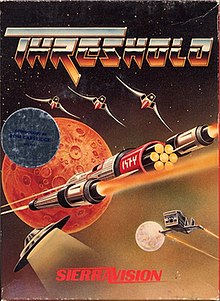Threshold (video game)
| Threshold | |
|---|---|
 Box cover with a C64 sticker | |
| Developer(s) | On-Line Systems |
| Publisher(s) | On-Line Systems Tigervision (2600) |
| Designer(s) | Warren Schwader |
| Programmer(s) | Apple II Warren Schwader Ken Williams Atari 8-bit Peter Oliphant[1] |
| Platform(s) | Apple II, Atari 8-bit, Atari 2600, VIC-20, Commodore 64, ColecoVision |
| Release | 1981: Apple, Atari, VIC 1982: 2600 1983: C64 1984: ColecoVision |
| Genre(s) | Fixed shooter |
Threshold is a space combat themed fixed shooter written by Warren Schwader and Ken Williams for the Apple II and published by On-Line Systems in 1981.[1] Inspired by Sega's Astro Blaster arcade game, Threshold introduces many new enemy ship types and wave formations as the game progresses.
Ports to other systems were all released on ROM cartridge: Atari 8-bit family and Commodore VIC-20 in 1981, Commodore 64 in 1983, and ColecoVision in 1984. An Atari 2600 adaptation was published by Tigervision in 1982.[2]
Schwader also wrote the 1983 Apple II platform game Sammy Lightfoot.[1]
Gameplay[]
The player controls the spaceship Threshold, using its laser weapon to destroy waves of alien attackers. When a wave is eliminated, another appears. As in Astro Blaster, firing the laser increases its temperature, and it cools down when not being used. If the temperature bar fills completely, then the weapon cannot be used until it fully cools. Once per ship, pulling back on the joystick activates a "warp drive" that slows the action down.
Development[]
The game was inspired by Ken Williams playing an Astro Blaster arcade machine in a store and calling Warren Schwader. In an interview in Halcyon Days, Schwader said:
Instead of trying to duplicate the game in every detail, I set out to just take the concept and run with it–after first playing Astro Blaster for hours on end though. No matter how hard we tried, we never could get to the end of that game. There were always more new creatures to discover and that kept us coming back. We set out to provide the same experience for Threshold players.[3]
It took two months to implement. Williams only worked on the project for two weeks of that time, writing the Apple II animation routines.[3]
Reception[]
Threshold sold approximately 250,000 copies.[3] Tigervision's Atari 2600 port received a "Certificate of Merit" in the "Best Science Fiction/Fantasy Videogame" category of the 1983 Arcade Awards.[4]
Reviewing the Apple II original for Creative Computing, David Lubar found the number of enemy types and waves to be a strong point.[5] He wrote, "The animation in Threshold is superb."[5] Giving an overall rating of "B", The Book of Atari Software 1983 wrote, "It's the usual scenario, with this exception: the game offers unusual depth and variety."[6] They commented that the stars in the animated background can be misinterpreted as enemy bullets.
Appraising the Atari 8-bit computer version, Electronic Games noticed the Astro Blaster connection and wrote "The graphics in Threshold are tremendous."[7] The reviewer disliked the loading that occurs every so often between levels and found the game overall to be too difficult.
References[]
- ^ a b c Hague, James. "The Giant List of Classic Game Programmers".
- ^ "Atari 2600 VCS Threshold". Atari Mania.
- ^ a b c Halcyon Days: Interviews with Classic Computer and Video Game Programmers. 1997.
- ^ "1983 Arcade Awards". Electronic Games. 1 (11): 23. January 1983.
- ^ a b Lubar, David (April 1982). "Let the Games Begin". Creative Computing. 8 (4): 56.
- ^ The Book of Atari Software 1983. The Book Company. 1983. p. 91.
- ^ Goldstein, Leigh (November 1982). "Computer Gaming: Threshold" (PDF). Electronic Games. 1 (9): 79.
External links[]
- 1981 video games
- Alien invasions in video games
- Apple II games
- Atari 8-bit family games
- Atari 2600 games
- Commodore VIC-20 games
- Commodore 64 games
- ColecoVision games
- Fixed shooters
- Video game clones
- Video games developed in the United States